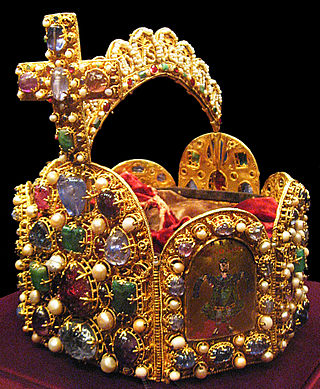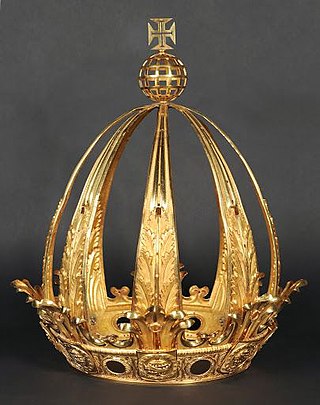
Crown jewels are the objects of metalwork and jewellery in the regalia of a current or former monarchy. They are often used for the coronation of a monarch and a few other ceremonial occasions. A monarch may often be shown wearing them in portraits, as they symbolize the power and continuity of the monarchy. Additions to them may be made, but since medieval times the existing items are typically passed down unchanged as they symbolize the continuity of the monarchy.

A crown is a traditional form of head adornment, or hat, worn by monarchs as a symbol of their power and dignity. A crown is often, by extension, a symbol of the monarch's government or items endorsed by it. The word itself is used, particularly in Commonwealth countries, as an abstract name for the monarchy itself, as distinct from the individual who inhabits it. A specific type of crown is employed in heraldry under strict rules. Indeed, some monarchies never had a physical crown, just a heraldic representation, as in the constitutional kingdom of Belgium, where no coronation ever took place; the royal installation is done by a solemn oath in parliament, wearing a military uniform: the King is not acknowledged as by divine right, but assumes the only hereditary public office in the service of the law; so he in turn will swear in all members of "his" federal government.

The Crown Jewels of the United Kingdom, originally the Crown Jewels of England, are a collection of royal ceremonial objects kept in the Tower of London, which include the coronation regalia and vestments worn by British monarchs.

The coat of arms of Brazil was created on 19 November 1889, four days after Brazil became a republic. It consists of the central emblem surrounded by coffee and tobacco branches, which were important crops in Brazil at that time. In the round shield in the center, the Southern Cross can be seen. The ring of 27 stars around it represents Brazil's 26 states and the Federal District.

Dona Maria Leopoldina of Austria was the first Empress of Brazil as the wife of Emperor Dom Pedro I from 12 October 1822 until her death. She was also Queen of Portugal during her husband's brief reign as King Dom Pedro IV from 10 March to 2 May 1826.

The Imperial Crown of the Holy Roman Empire, a hoop crown with a characteristic octagonal shape, was the coronation crown of the Holy Roman Emperor, probably from the late 10th century until the dissolution of the Holy Roman Empire in 1806. The crown was used in the coronation of the King of the Romans, the title assumed by the Emperor-elect immediately after his election. It is now kept in the Imperial Treasury at the Hofburg in Vienna, Austria.

The French Crown Jewels comprise the crowns, orb, sceptres, diadems and jewels that were symbols of Royal power between 752 and 1825. These were worn by many Kings and Queens of France as well as Emperor Napoleon. The set was finally broken up, with most of it sold off in 1885 by the Third Republic. The surviving French Crown Jewels, principally a set of historic crowns, diadems and parures, are mainly on display in the Galerie d'Apollon of the Louvre, France's premier museum and former royal palace, together with the Regent Diamond, the Sancy Diamond and the 105-carat (21.0 g) Côte-de-Bretagne red spinel, carved into the form of a dragon. In addition, some gemstones and jewels are on display in the Treasury vault of the Mineralogy gallery in the National Museum of Natural History.

Regalia is the set of emblems, symbols, or paraphernalia indicative of royal status, as well as rights, prerogatives and privileges enjoyed by a sovereign, regardless of title. The word originally referred to the elaborate formal dress and accessories of a sovereign, but now it also refers to any type of elaborate formal dress. The word stems from the Latin substantivation of the adjective regalis, "regal", itself from rex, "king". It is sometimes used in the singular, regale.

The Austrian Crown Jewels are the regalia and vestments worn by the Holy Roman Emperor, and later by the Emperor of Austria, during the coronation ceremony and other state functions. The term refers to the following objects: the crowns, sceptres, orbs, swords, rings, crosses, holy relics and royal robes, as well as several other objects connected with the ceremony. The collection dates from the 10th to the 19th centuries, and it reflects more than a thousand years of European history. It is kept in the Imperial Treasury at the Hofburg Palace in Vienna, Austria.

The Imperial Crown of Russia, also known as the great imperial crown, was used by the monarchs of Russia from 1762 until the Russian monarchy's abolition in 1917. The great imperial crown was first used in a coronation by Catherine the Great, and it was last worn at the coronation of Nicholas II. It was displayed prominently next to Nicholas II on a cushion at the State Opening of the Russian Duma inside the Winter Palace in St. Petersburg in 1906. It survived the 1917 revolution and is currently on display in Moscow at the Kremlin Armoury's State Diamond Fund.

The Museu Imperial de Petrópolis is a museum in the historic center of Petrópolis, Rio de Janeiro, Brazil. It is housed in the Petrópolis Imperial Palace, the former summer residence of Emperor Pedro II, which was built starting in 1845.

The Jewels of the Empire of Brazil were the official ornaments and regalia worn by the Emperor of Brazil during the Brazilian monarchical period. They were used by the Brazilian Imperial Family until 1889, among them the famous Crown of Dom Pedro II. Part of the jewels are on display at the National Museum of Brazil in Rio de Janeiro, and others have been at the Imperial Museum of Brazil in Petrópolis since 1943. Some are also in Brasília.

Dona Paula was a princess of the Empire of Brazil and thus, a member of the Brazilian branch of the Portuguese House of Braganza. Her parents were Emperor Dom Pedro I, the first ruler of an independent Brazil, and Archduchess Leopoldina of Austria. Born in Rio de Janeiro, Paula was the couple's third child; she lost her mother at the age of three and her father at the age of eight, when he abdicated and left Brazil for Portugal, where he wanted to restore the throne of Paula's eldest sister, Maria da Glória, who should have become queen regnant of Portugal.

The Imperial Order of Our Lord Jesus Christ, simply named Order of Christ, is an order of chivalry instituted by emperor Pedro I of Brazil on 7 December 1822, on the basis of the Portuguese Order of Christ founded by King Dom Dinis and Pope John XXII in 1316–1319.

Regalia of the Russian tsars from the 13th to the 20th centuries of the history of Russia, are the insignia of tsars and emperors of Russia. Some of the artefacts were changed or substituted, the most radical change happened in the 18th century, when Peter the Great reformed the state and transitioned it to European-style monarchy.

Coronations in the Americas were previously held by multiple countries on both continents, with the majority occurring in Latin America. They were held by endemic constitutional monarchies with their own resident monarch. There are no longer any endemic American monarchies.

The Portuguese crown jewels, also known as the Royal Treasure, are the pieces of jewelry, regalia, and vestments that were used by the Kings and Queens of Portugal during the time of the Portuguese Monarchy. Over the nine centuries of Portuguese history, the Portuguese crown jewels have lost and gained many pieces. Most of the current set of the Portuguese crown jewels are from the reigns of King João VI and King Luís I.

The Coronation of the Emperor of Brazil was the religious act of consecration during which the monarchs of the Empire of Brazil were solemnly blessed, anointed, crowned, invested with the other items of the imperial regalia and enthroned, according to the usages of the Catholic Church, the Empire's official, established Church. The coronation of the Brazilian monarch confirmed the accession of a new emperor to the throne, and corresponded to similar rites that took place in other Christian monarchies. The two Brazilian emperors, Pedro I and Pedro II underwent the ceremony of coronation, on 1 December 1822 and 18 July 1841, respectively. Those remain the two sole acts of coronation that took place in the South American continent.

The crown of Pedro I is the first imperial crown of Brazil and was made for emperor Pedro I of Brazil. It was made in 1822 for his coronation and was the symbol and emblem of Brazilian imperial power until it was replaced in 1841 by the crown of his son and successor Pedro II. It is one of the jewels of the Brazilian Empire and is now on display at the Imperial Museum in Petrópolis.





















